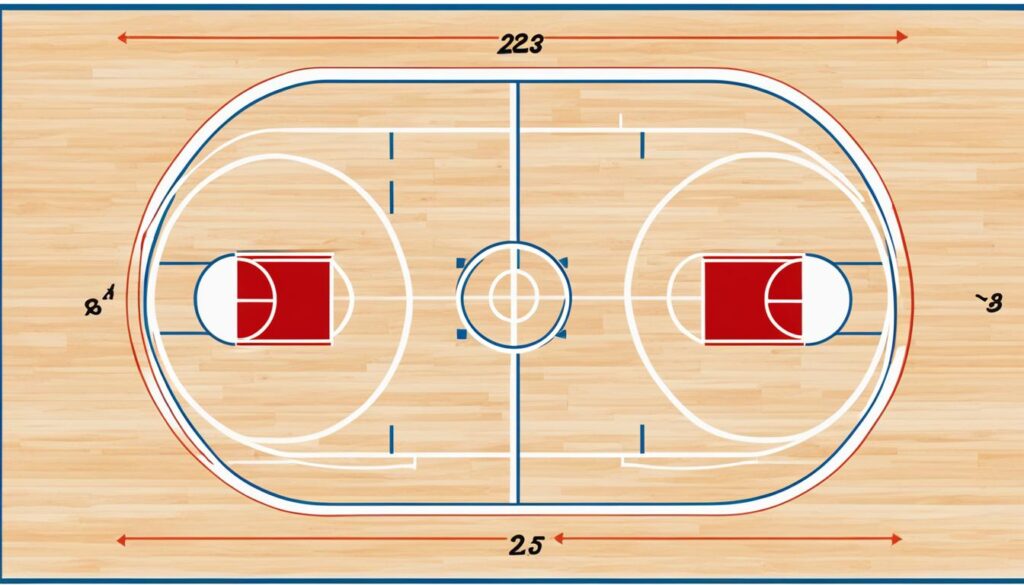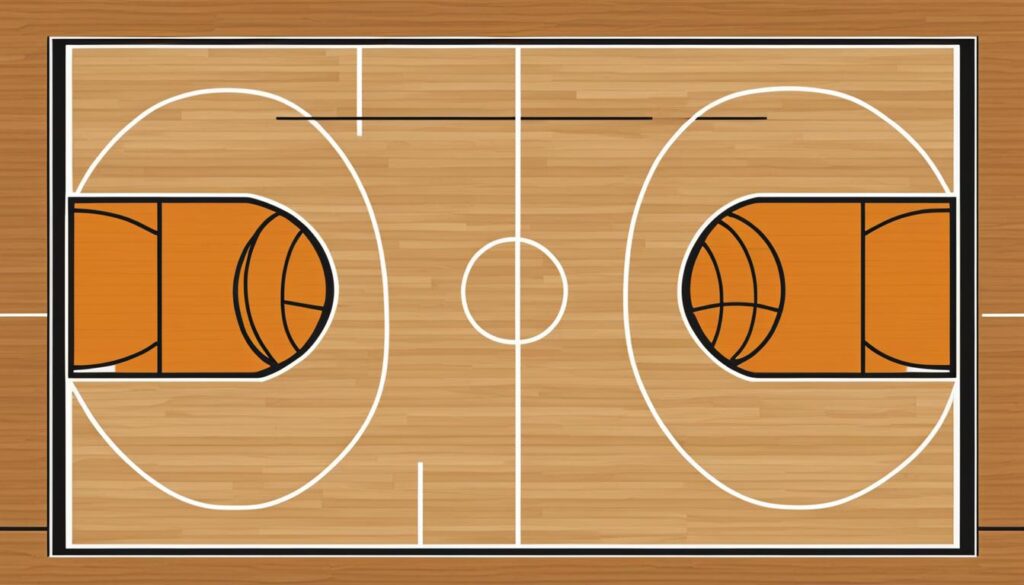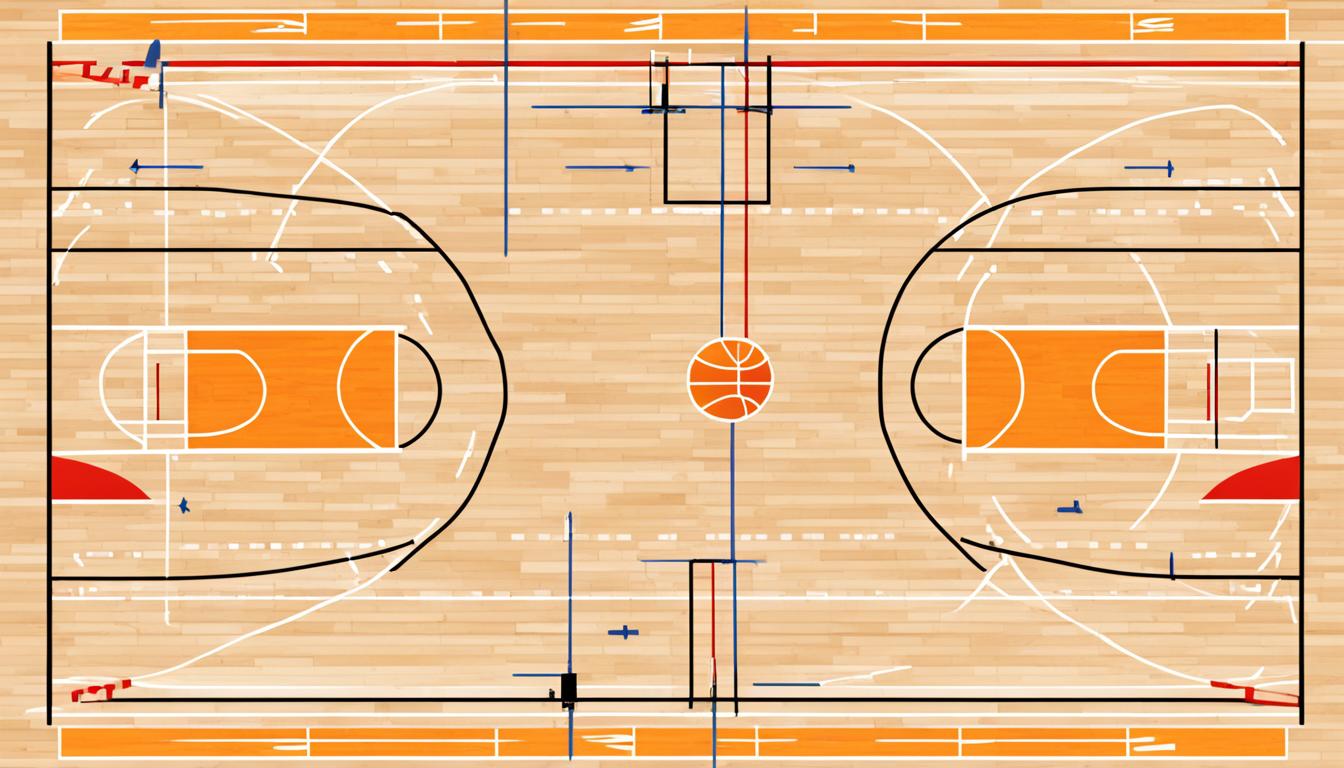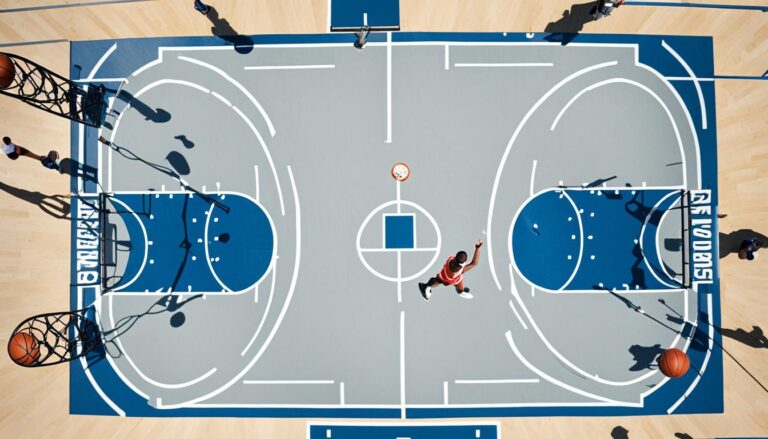Understanding the dimensions of a basketball court is essential for players, coaches, and even fans. Whether you’re playing on a professional court or a backyard hoop, knowing the standard basketball court dimensions ensures a fair and consistent game. In this article, we’ll dive into the different sizes and standards of basketball courts, ranging from the professional level to amateur and home courts.
Key Takeaways:
- Understanding basketball court dimensions is crucial for players, coaches, and fans alike.
- Basketball courts come in various sizes and standards depending on the level of play.
- The NBA, WNBA, and FIBA have specific court dimensions for professional basketball.
- Amateur and youth basketball courts have their own size requirements.
- Home basketball courts can be customized to fit available space.
Basketball Court Dimensions Overview
In order to fully understand the different standards and sizes of basketball courts, it is essential to have a general overview of basketball court dimensions. The length, width, and height of a basketball court are key components that determine the playing area and layout of the game.
Length:
The standard length of a basketball court is 94 feet for professional play, including the NBA and WNBA. However, at the high school, college, and recreational levels, the length may vary. Typically, high school courts have a length of 84 feet, while college courts are slightly longer at 94 feet.
Width:
The width of a basketball court is consistent across all levels of play, with a standard measurement of 50 feet. This allows for equal spacing between the sidelines and provides sufficient playing area for the game.
Height:
While not directly related to the court’s dimensions, the height of the basketball rim is an important aspect of the game. The rim’s height is universally set at 10 feet for all levels, ensuring a consistent challenge and standard for players.
“Understanding the basic dimensions of a basketball court is essential for players, coaches, and enthusiasts alike. It sets the foundation for fair and consistent play across different levels, from recreational games to professional leagues.”
With this overview of basketball court dimensions in mind, we can now delve into the specific standards for professional courts in the NBA, WNBA, and FIBA in the next section.
Professional Basketball Court Dimensions
Professional basketball courts have specific dimensions and standards that ensure fair play and a consistent experience for players. These standards are followed by prominent leagues such as the NBA, WNBA, and FIBA. In this section, we will explore the dimensions and specifications for professional basketball courts.
NBA Court Dimensions
The NBA, widely regarded as the premier basketball league in the world, has strict regulations for court dimensions. According to NBA standards, the length of the court should be 94 feet (28.65 meters), while the width should measure 50 feet (15.24 meters). The top of the hoop stands at a height of 10 feet (3.05 meters) above the floor. The three-point line is set at a distance of 23 feet 9 inches (7.24 meters) from the center of the hoop, with the corners measuring 22 feet (6.7 meters) from the hoop. These dimensions ensure a standard playing field for all NBA games.
WNBA Court Standards
The WNBA, the premier women’s professional basketball league, follows slightly different court standards compared to the NBA. The length of a WNBA court is also 94 feet (28.65 meters), but the width is slightly narrower at 44 feet (13.41 meters). The hoop height remains the same at 10 feet (3.05 meters). The three-point line is set at a distance of 22 feet 1.75 inches (6.75 meters) from the center of the hoop. These dimensions accommodate the unique style of play in women’s professional basketball.
FIBA International Court Specifications
FIBA, the international governing body for basketball, has its own set of court specifications that apply to professional basketball outside of the NBA and WNBA. According to FIBA standards, the court length should be 91.86 feet (28 meters), and the width should measure 49.21 feet (15 meters). The height of the hoop is consistent with NBA regulations at 10 feet (3.05 meters) above the floor. The three-point line is set at a distance of 22.15 feet (6.75 meters) from the center of the hoop. These specifications ensure uniformity in international basketball competitions.
| League | Length | Width | Hoop Height | Three-Point Line Distance (from center of hoop) |
|---|---|---|---|---|
| NBA | 94 feet (28.65 meters) | 50 feet (15.24 meters) | 10 feet (3.05 meters) | 23 feet 9 inches (7.24 meters) |
| WNBA | 94 feet (28.65 meters) | 44 feet (13.41 meters) | 10 feet (3.05 meters) | 22 feet 1.75 inches (6.75 meters) |
| FIBA | 91.86 feet (28 meters) | 49.21 feet (15 meters) | 10 feet (3.05 meters) | 22.15 feet (6.75 meters) |
Amateur and Youth Basketball Court Sizes
In addition to professional basketball courts, there are specific dimensions and requirements for amateur and youth basketball courts. These guidelines ensure that players of all ages have an appropriate court size for their level of play. Let’s explore the dimensions for high school, college, and junior/middle school courts.
High School Basketball Court Requirements
When it comes to high school basketball, the court dimensions follow the guidelines set by the National Federation of State High School Associations (NFHS). The standard dimensions for a high school basketball court are:
| Component | Measurement |
|---|---|
| Court Length | 84 feet |
| Court Width | 50 feet |
| Three-Point Line Distance | 19 feet, 9 inches |
| Free Throw Line Distance | 15 feet |
These dimensions provide a suitable playing area for high school basketball games and tournaments, ensuring fairness and consistency across different schools and venues.
College Basketball Court Dimensions
College basketball courts follow the guidelines set by the National Collegiate Athletic Association (NCAA). The dimensions for a college basketball court are:
| Component | Measurement |
|---|---|
| Court Length | 94 feet |
| Court Width | 50 feet |
| Three-Point Line Distance (Men’s) | 22 feet, 1.75 inches |
| Three-Point Line Distance (Women’s) | 20 feet, 9 inches |
| Free Throw Line Distance | 15 feet |
College basketball courts have slightly larger dimensions compared to high school courts, accommodating the higher level of play and athleticism.
Junior and Middle School Court Guidelines
For junior and middle school basketball, the court dimensions may vary based on age and league regulations. The following are general guidelines for junior and middle school basketball court dimensions:
| Age Group | Court Length | Court Width |
|---|---|---|
| Elementary (Ages 8-10) | 74 feet | 42 feet |
| Middle School (Ages 11-14) | 84 feet | 50 feet |
These dimensions provide appropriate court sizes for young players, allowing them to learn the game and develop their skills in a suitable environment.
Understanding the dimensions and requirements for amateur and youth basketball courts is crucial for creating an optimal playing experience and promoting fair competition at every level.
Understanding Home Basketball Court Dimensions
When planning to create a basketball court at home, it’s crucial to understand the dimensions involved. Whether you have ample space in your backyard or want to utilize a smaller area for a half-court setup, knowing the right sizes and considering important factors will ensure an enjoyable basketball experience for everyone.
Half-Court Basketball Sizes
If you have limited space, setting up a half-court basketball court might be the perfect solution. Half-courts provide an opportunity to enjoy the game while accommodating space restrictions. The dimensions of a half-court can vary, but the typical size is approximately 47 by 50 feet. This allows for a playing area that is half the size of a regular full-court.
Building a half-court requires careful consideration of the available space, ensuring there is sufficient room to shoot, dribble, and move around comfortably. It’s important to mark the court boundaries clearly to maintain the integrity of the game.
Backyard Basketball Court Considerations
Creating a backyard basketball court is an excellent way to enjoy the game with family and friends. Before embarking on this project, there are a few important considerations to keep in mind.
Safety: Ensure that the surface of the court is even and free from any potential hazards. Consider using materials that provide sufficient grip to avoid slips and falls.
Placement: Take into account the size and shape of your backyard. Choose a location that allows for adequate space and clearance around the court. Keep in mind factors such as surrounding trees, structures, and other potential obstructions.
Drainage: Proper drainage is essential to prevent water accumulation on the court. Consider the natural slope of your backyard and consult with experts to ensure efficient water runoff.
Fencing and Lighting: Installing a protective fence is recommended to prevent stray balls from causing damage or interrupting neighboring properties. Additionally, consider adding adequate lighting to extend playing time into the evening hours.

A backyard basketball court can provide endless hours of fun and exercise. By understanding the necessary dimensions and considering important factors, you can create a safe and enjoyable basketball environment right in the comfort of your own home.
Indoor vs. Outdoor Basketball Court Sizing
When it comes to basketball court sizing, there are distinct differences between indoor and outdoor courts. The dimensions and considerations for each type of court vary, based on factors such as space availability, playing surface, and intended use.
Indoor basketball courts, typically found in gyms or sports complexes, have standardized dimensions that comply with professional standards. These courts are usually designed for competitive play and adhere to specific regulations set by organizations like the NBA or FIBA.
On the other hand, outdoor basketball courts come in a variety of sizes and shapes. They can be found in parks, school yards, or residential areas. Outdoor courts often allow for more flexibility in sizing compared to their indoor counterparts.
One key difference between indoor and outdoor basketball court sizing is the playing surface. Indoor courts typically feature hardwood floors, which require a smooth and level installation. Outdoor courts, on the other hand, can be made of materials such as asphalt or concrete. The size of the playing surface for indoor and outdoor courts can also differ, with outdoor courts often having larger dimensions to accommodate multiple games or players.
Additionally, outdoor courts may have additional space around the court to account for spectator seating or other recreational activities. This extra space is not typically found in indoor courts, where the focus is solely on the playing area.
While there is no strict rule for the dimensions of outdoor basketball courts, there are commonly used sizes that provide a suitable playing area. Popular outdoor court sizes include:
- Full-size court: Approximately 94 feet long and 50 feet wide, similar to professional indoor courts.
- Half-court: A smaller version of the full-size court, usually measuring around 47 feet long and 50 feet wide.
- Backyard or residential courts: These can vary in size, ranging from compact half-courts to custom designs that fit the available space.
When planning to install an outdoor basketball court, it’s important to consider factors such as available space, local regulations, and intended use. It’s also crucial to ensure proper safety measures are in place, such as adequate shock absorption for the playing surface and appropriate lighting for nighttime play.
In conclusion, while indoor and outdoor basketball courts share similarities in terms of gameplay, their sizing requirements and considerations differ significantly. Understanding these differences is essential when designing, building, or choosing the right court for your needs.
Regulation Markings and Layouts on Basketball Courts
Court Lines and Paint Area Details
In order to maintain consistency and ensure fair play, basketball courts are marked with specific lines and paint areas. These markings serve as a guide for players, referees, and spectators to understand the boundaries and key areas of the court.
The most common court lines include:
- The center line, which divides the court into two halves.
- The key, also known as the restricted area, which is a painted rectangular area located near each basket.
- The three-point line, which surrounds the key and extends outwards in the shape of an arc.
- The free throw line, which is located at the center of the key and is used for free throw shots.
- The baseline, which marks the boundary at the ends of the court.
The paint areas, including the key and the restricted area, have specific dimensions that must be followed according to the regulations. These dimensions ensure consistency across different basketball courts.

Basketball Goal and Backboard Measurements
The basketball goal and backboard are essential components of a basketball court. They have specific measurements that need to be followed for consistent and fair gameplay.
The standard basketball goal height is 10 feet (3.05 meters) from the ground to the rim. This height is used in most professional and recreational basketball games.
Backboards come in various sizes and materials, but they must meet specific measurements to ensure consistency. The regulations specify that backboards should have a rectangular shape with a width of 6 feet (1.83 meters) and a height of 3.5 feet (1.07 meters).
The exact specifications for basketball goals and backboards may vary depending on the level of play and governing organizations, but the above measurements are commonly used in regulation courts.
The Evolution of Basketball Court Dimensions
Throughout the history of basketball, the dimensions of the court have undergone significant changes. Understanding the evolution of basketball court dimensions provides valuable insights into the development and growth of the sport.
In the early years of basketball, court sizes varied widely and were not standardized. The first basketball game, played in 1891, took place on a court measuring just 50 feet by 35 feet.
Over time, as the popularity of the sport grew, there was a need for consistency and standardized court dimensions. In 1893, the court size was standardized to 94 feet by 50 feet, a dimension that would become the foundation for future changes.
In the following decades, as the game evolved, basketball court dimensions continued to change to accommodate the advancements in the sport. Notable changes occurred in the early 1930s when the court size was reduced to its current dimensions of 94 feet by 50 feet.
The evolution of basketball court dimensions was driven by various factors, including the need to create a standardized playing surface for fair competition, the development of specific positions and strategies that influenced court design, and advancements in player athleticism and game style.
Today, the standard dimensions for basketball courts are regulated by organizations such as the NBA, WNBA, and FIBA, ensuring consistency in court size and layout across different levels of play.
Summary of Basketball Court Dimension Evolution:
- In the early years, court sizes were inconsistent and not standardized.
- In 1893, the court size was standardized to 94 feet by 50 feet.
- Advancements in the sport led to changes in court dimensions.
- Current standard dimensions are regulated by basketball organizations.
Conclusion
In conclusion, understanding basketball court dimensions is essential for players, coaches, and facility managers alike. By knowing the sizes and standards, individuals can ensure they are playing on a court that meets the requirements of their level of play, whether it’s professional, amateur, or for home use.
Throughout this article, we have covered the various dimensions and standards for basketball courts at different levels, including professional leagues such as the NBA, WNBA, and FIBA, as well as high school, college, and junior/middle school courts. We have also discussed the considerations for building a home basketball court, including half-court sizes and backyard court guidelines.
Additionally, we explored the differences between indoor and outdoor court sizing and provided a detailed overview of the regulation markings, court lines, and paint area details. Understanding these markings is crucial for players to navigate the court effectively and play by the rules.
By examining the evolution of basketball court dimensions, we gained insight into the historical changes that have shaped the game. This knowledge allows us to appreciate the current standard sizes and the reasons behind them.
Overall, this article has provided a comprehensive guide to basketball court dimensions. Whether you’re a basketball enthusiast, a player, or involved in court construction, we hope that this information has been informative and helpful. By understanding the sizes and standards, you can ensure a better playing experience and contribute to the growth and development of the game.
FAQ
What are the standard dimensions of a basketball court?
The standard dimensions of a basketball court are 94 feet in length and 50 feet in width.
What is the height of a basketball hoop?
The height of a basketball hoop is 10 feet.
How long is an NBA basketball court?
An NBA basketball court is 94 feet long.
What are the dimensions of an NBA basketball court?
An NBA basketball court is 94 feet long and 50 feet wide.
Are FIBA and NBA basketball court dimensions the same?
FIBA basketball court dimensions are slightly different from NBA dimensions. A FIBA court is 28 meters long and 15 meters wide, which is equivalent to approximately 91.86 feet by 49.21 feet.
What are the dimensions of a high school basketball court?
The dimensions of a high school basketball court are typically 84 feet in length and 50 feet in width.
What are the dimensions of a college basketball court?
The dimensions of a college basketball court are the same as an NBA court, which is 94 feet in length and 50 feet in width.
What is the size of a half-court basketball court?
A half-court basketball court is typically 47 feet in length and 50 feet in width.
What should I consider when building a backyard basketball court?
When building a backyard basketball court, consider the available space, surface material, and any local regulations or permits required.
Are there any differences between indoor and outdoor basketball court dimensions?
Generally, there are no significant differences in dimensions between indoor and outdoor basketball courts. The main differences lie in the surface material and weather considerations for outdoor courts.
What are the regulation markings on a basketball court?
Regulation markings on a basketball court include the key, three-point line, free throw line, sidelines, and baseline.
What are the measurements for a basketball goal and backboard?
The basketball goal is positioned 10 feet above the ground, and the backboard is typically rectangular and measures 6 feet by 3.5 feet.
How have basketball court dimensions evolved over time?
Basketball court dimensions have evolved over time due to changes in the rules and strategies of the game. The current standard sizes have been established to ensure fair play and optimal gameplay.














+ There are no comments
Add yours